| Type: | Package |
| Title: | Fast Permutation Based Two Sample Tests |
| Version: | 2.0.1 |
| Description: | Fast randomization based two sample tests. Testing the hypothesis that two samples come from the same distribution using randomization to create p-values. Included tests are: Kolmogorov-Smirnov, Kuiper, Cramer-von Mises, Anderson-Darling, Wasserstein, and DTS. The default test (two_sample) is based on the DTS test statistic, as it is the most powerful, and thus most useful to most users. The DTS test statistic builds on the Wasserstein distance by using a weighting scheme like that of Anderson-Darling. See the companion paper at <doi:10.48550/arXiv.2007.01360> or https://codowd.com/public/DTS.pdf for details of that test statistic, and non-standard uses of the package (parallel for big N, weighted observations, one sample tests, etc). We also include the permutation scheme to make test building simple for others. |
| License: | GPL-2 | GPL-3 [expanded from: GPL (≥ 2)] |
| Encoding: | UTF-8 |
| LinkingTo: | cpp11 |
| RoxygenNote: | 7.2.3 |
| URL: | https://twosampletest.com, https://github.com/cdowd/twosamples |
| BugReports: | https://github.com/cdowd/twosamples/issues |
| Suggests: | testthat (≥ 3.0.0) |
| Config/testthat/edition: | 3 |
| NeedsCompilation: | yes |
| Packaged: | 2023-06-23 18:50:48 UTC; cdowd |
| Author: | Connor Dowd |
| Maintainer: | Connor Dowd <cd@codowd.com> |
| Repository: | CRAN |
| Date/Publication: | 2023-06-23 19:30:02 UTC |
Anderson-Darling Test
Description
A two-sample test based on the Anderson-Darling test statistic (ad_stat).
Usage
ad_test(a, b, nboots = 2000, p = default.p, keep.boots = T, keep.samples = F)
ad_stat(a, b, power = def_power)
Arguments
a |
a vector of numbers (or factors – see details) |
b |
a vector of numbers |
nboots |
Number of bootstrap iterations |
p |
power to raise test stat to |
keep.boots |
Should the bootstrap values be saved in the output? |
keep.samples |
Should the samples be saved in the output? |
power |
power to raise test stat to |
Details
The AD test compares two ECDFs by looking at the weighted sum of the squared differences between them – evaluated at each point in the joint sample. The weights are determined by the variance of the joint ECDF at that point, which peaks in the middle of the joint distribution (see figure below). Formally – if E is the ECDF of sample 1, F is the ECDF of sample 2, and G is the ECDF of the joint sample then
AD = \sum_{x \in k} \left({|E(x)-F(x)| \over \sqrt{2G(x)(1-G(x))/n} }\right)^p
where k is the joint sample. The test p-value is calculated by randomly resampling two samples of the same size using the combined sample. Intuitively the AD test improves on the CVM test by giving lower weight to noisy observations.
In the example plot below, we see the variance of the joint ECDF over the range of the data. It clearly peaks in the middle of the joint sample.
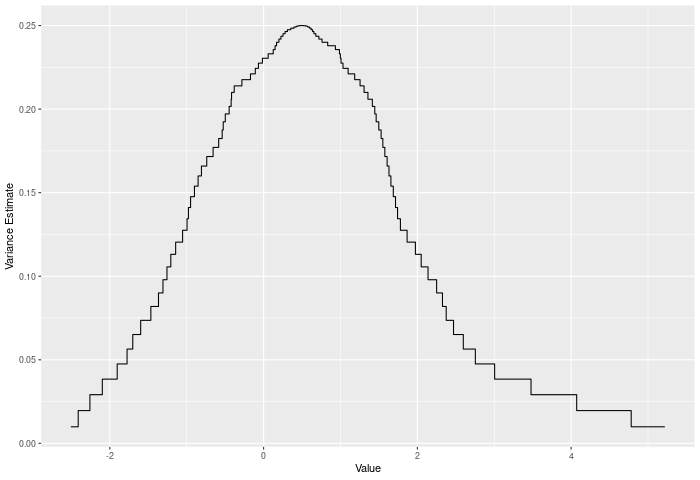
In the example plot below, the AD statistic is the weighted sum of the heights of the vertical lines, where weights are represented by the shading of the lines.
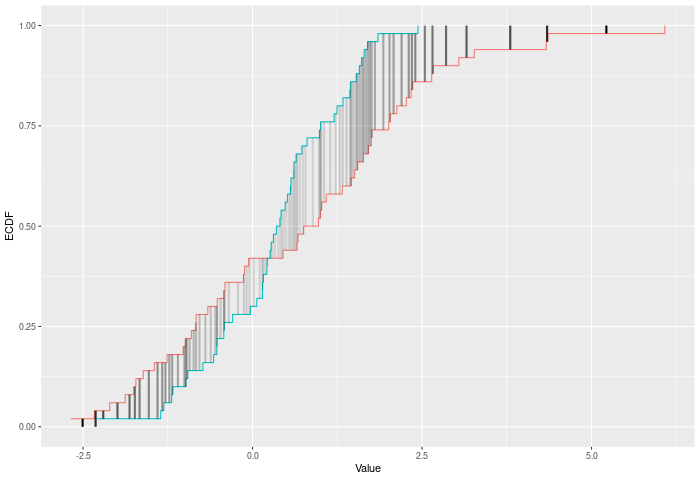
Inputs a and b can also be vectors of ordered (or unordered) factors, so long as both have the same levels and orderings. When possible, ordering factors will substantially increase power.
Value
Output is a length 2 Vector with test stat and p-value in that order. That vector has 3 attributes – the sample sizes of each sample, and the number of bootstraps performed for the pvalue.
Functions
-
ad_test(): Permutation based two sample Anderson-Darling test -
ad_stat(): Permutation based two sample Anderson-Darling test
See Also
dts_test() for a more powerful test statistic. See cvm_test() for the predecessor to this test statistic. See dts_test() for the natural successor to this test statistic.
Examples
set.seed(314159)
vec1 = rnorm(20)
vec2 = rnorm(20,0.5)
out = ad_test(vec1,vec2)
out
summary(out)
plot(out)
# Example using ordered factors
vec1 = factor(LETTERS[1:5],levels = LETTERS,ordered = TRUE)
vec2 = factor(LETTERS[c(1,2,2,2,4)],levels = LETTERS, ordered=TRUE)
ad_test(vec1,vec2)
Combine two objects of class twosamples
Description
This function combines two twosamples objects – concatenating bootstraps, recalculating pvalues, etc.
It only works if both objects were created with "keep.boots=T" This function is intended for one main purposes: combining parallized null calculations and then plotting those combined outputs.
Usage
combine.twosamples(x, y, check.sample = T)
Arguments
x |
a twosamples object |
y |
a different twosamples object from the same |
check.sample |
check that the samples saved in each object are the same? (can be slow) |
Value
a twosamples object that correctly re-calculates the p-value and determines all the other attributes
See Also
twosamples_class, plot.twosamples, dts_test
Examples
vec1 = rnorm(10)
vec2 = rnorm(10,1)
out1 = dts_test(vec1,vec2)
out2 = dts_test(vec1,vec2)
combined = combine.twosamples(out1,out2)
summary(out1)
summary(out2)
summary(combined)
plot(combined)
Cramer-von Mises Test
Description
A two-sample test based on the Cramer-Von Mises test statistic (cvm_stat).
Usage
cvm_test(a, b, nboots = 2000, p = default.p, keep.boots = T, keep.samples = F)
cvm_stat(a, b, power = def_power)
Arguments
a |
a vector of numbers (or factors – see details) |
b |
a vector of numbers |
nboots |
Number of bootstrap iterations |
p |
power to raise test stat to |
keep.boots |
Should the bootstrap values be saved in the output? |
keep.samples |
Should the samples be saved in the output? |
power |
power to raise test stat to |
Details
The CVM test compares two ECDFs by looking at the sum of the squared differences between them – evaluated at each point in the joint sample. Formally – if E is the ECDF of sample 1 and F is the ECDF of sample 2, then
CVM = \sum_{x\in k}|E(x)-F(x)|^p
where k is the joint sample. The test p-value is calculated by randomly resampling two samples of the same size using the combined sample. Intuitively the CVM test improves on KS by using the full joint sample, rather than just the maximum distance – this gives it greater power against shifts in higher moments, like variance changes.
In the example plot below, the CVM statistic is the sum of the heights of the vertical black lines.
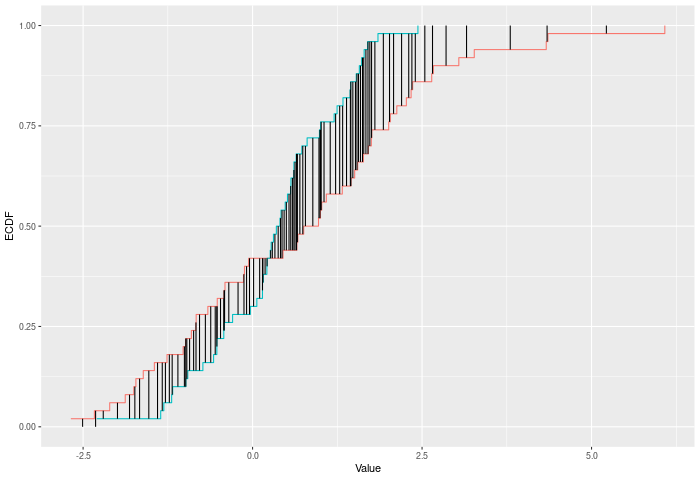
Inputs a and b can also be vectors of ordered (or unordered) factors, so long as both have the same levels and orderings. When possible, ordering factors will substantially increase power.
Value
Output is a length 2 Vector with test stat and p-value in that order. That vector has 3 attributes – the sample sizes of each sample, and the number of bootstraps performed for the pvalue.
Functions
-
cvm_test(): Permutation based two sample Cramer-Von Mises test -
cvm_stat(): Permutation based two sample Cramer-Von Mises test
See Also
dts_test() for a more powerful test statistic. See ks_test() or kuiper_test() for the predecessors to this test statistic. See wass_test() and ad_test() for the successors to this test statistic.
Examples
set.seed(314159)
vec1 = rnorm(20)
vec2 = rnorm(20,0.5)
out = cvm_test(vec1,vec2)
out
summary(out)
plot(out)
# Example using ordered factors
vec1 = factor(LETTERS[1:5],levels = LETTERS,ordered = TRUE)
vec2 = factor(LETTERS[c(1,2,2,2,4)],levels = LETTERS, ordered=TRUE)
cvm_test(vec1,vec2)
Kolmogorov-Smirnov Test
Description
A two-sample test using the Kolmogorov-Smirnov test statistic (ks_stat).
Usage
ks_test(a, b, nboots = 2000, p = default.p, keep.boots = T, keep.samples = F)
ks_stat(a, b, power = def_power)
Arguments
a |
a vector of numbers (or factors – see details) |
b |
a vector of numbers |
nboots |
Number of bootstrap iterations |
p |
power to raise test stat to |
keep.boots |
Should the bootstrap values be saved in the output? |
keep.samples |
Should the samples be saved in the output? |
power |
power to raise test stat to |
Details
The KS test compares two ECDFs by looking at the maximum difference between them. Formally – if E is the ECDF of sample 1 and F is the ECDF of sample 2, then
KS = max |E(x)-F(x)|^p
for values of x in the joint sample. The test p-value is calculated by randomly resampling two samples of the same size using the combined sample.
In the example plot below, the KS statistic is the height of the vertical black line.
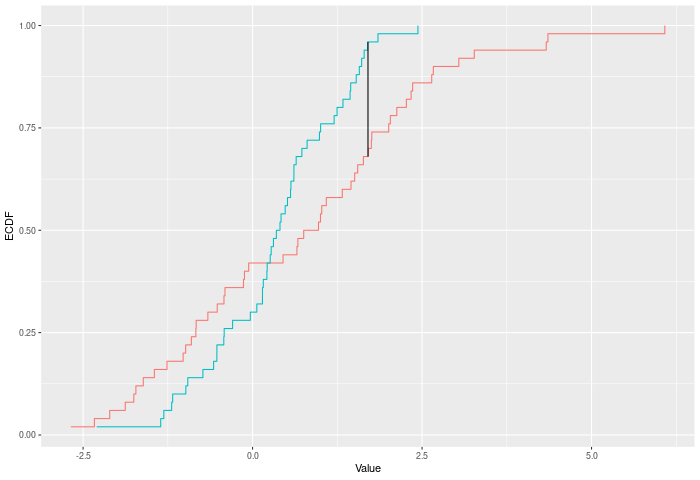
Inputs a and b can also be vectors of ordered (or unordered) factors, so long as both have the same levels and orderings. When possible, ordering factors will substantially increase power.
Value
Output is a length 2 Vector with test stat and p-value in that order. That vector has 3 attributes – the sample sizes of each sample, and the number of bootstraps performed for the pvalue.
Functions
-
ks_test(): Permutation based two sample Kolmogorov-Smirnov test -
ks_stat(): Permutation based two sample Kolmogorov-Smirnov test
See Also
dts_test() for a more powerful test statistic. See kuiper_test() or cvm_test() for the natural successors to this test statistic.
Examples
set.seed(314159)
vec1 = rnorm(20)
vec2 = rnorm(20,0.5)
out = ks_test(vec1,vec2)
out
summary(out)
plot(out)
# Example using ordered factors
vec1 = factor(LETTERS[1:5],levels = LETTERS,ordered = TRUE)
vec2 = factor(LETTERS[c(1,2,2,2,4)],levels = LETTERS, ordered=TRUE)
ks_test(vec1,vec2)
Kuiper Test
Description
A two-sample test based on the Kuiper test statistic (kuiper_stat).
Usage
kuiper_test(
a,
b,
nboots = 2000,
p = default.p,
keep.boots = T,
keep.samples = F
)
kuiper_stat(a, b, power = def_power)
Arguments
a |
a vector of numbers (or factors – see details) |
b |
a vector of numbers |
nboots |
Number of bootstrap iterations |
p |
power to raise test stat to |
keep.boots |
Should the bootstrap values be saved in the output? |
keep.samples |
Should the samples be saved in the output? |
power |
power to raise test stat to |
Details
The Kuiper test compares two ECDFs by looking at the maximum positive and negative difference between them. Formally – if E is the ECDF of sample 1 and F is the ECDF of sample 2, then
KUIPER = |max_x E(x)-F(x)|^p + |max_x F(x)-E(x)|^p
. The test p-value is calculated by randomly resampling two samples of the same size using the combined sample.
In the example plot below, the Kuiper statistic is the sum of the heights of the vertical black lines.
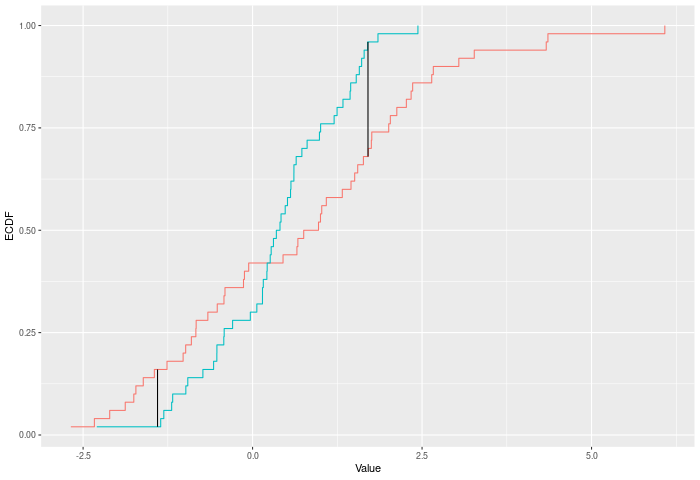
Inputs a and b can also be vectors of ordered (or unordered) factors, so long as both have the same levels and orderings. When possible, ordering factors will substantially increase power.
Value
Output is a length 2 Vector with test stat and p-value in that order. That vector has 3 attributes – the sample sizes of each sample, and the number of bootstraps performed for the pvalue.
Functions
-
kuiper_test(): Permutation based two sample Kuiper test -
kuiper_stat(): Permutation based two sample Kuiper test
See Also
dts_test() for a more powerful test statistic. See ks_test() for the predecessor to this test statistic, and cvm_test() for its natural successor.
Examples
set.seed(314159)
vec1 = rnorm(20)
vec2 = rnorm(20,0.5)
out = kuiper_test(vec1,vec2)
out
summary(out)
plot(out)
# Example using ordered factors
vec1 = factor(LETTERS[1:5],levels = LETTERS,ordered = TRUE)
vec2 = factor(LETTERS[c(1,2,2,2,4)],levels = LETTERS, ordered=TRUE)
kuiper_test(vec1,vec2)
Permutation Test Builder
Description
(Warning! This function has changed substantially between v1.2.0 and v2.0.0) This function takes a two-sample test statistic and produces a function which performs randomization tests (sampling with replacement) using that test stat. This is an internal function of the twosamples package.
Usage
permutation_test_builder(test_stat_function, default.p = 2)
Arguments
test_stat_function |
a function of the joint vector and a label vector producing a positive number, intended as the test-statistic to be used. |
default.p |
This allows for some introduction of defaults and parameters. Typically used to control the power functions raise something to. |
Details
test_stat_function must be structured to take two vectors – the first a combined sample vector and the second a logical vector indicating which sample each value came from, as well as a third and fourth value. i.e. (fun = function(jointvec,labelvec,val1,val2) ...). See examples.
Conversion Function
Test stat functions designed to work with the prior version of permutation_test_builder will not work.
E.g. If your test statistic is
mean_diff_stat = function(x,y,pow) abs(mean(x)-mean(y))^pow
then permutation_test_builder(mean_diff_stat,1) will no longer work as intended, but it will if you run the below code first.
perm_stat_helper = function(stat_fn,def_power) {
output = function(joint,vec_labels,power=def_power,na) {
a = joint[vec_labels]
b = joint[!vec_labels]
stat_fn(a,b,power)
}
output
}
mean_diff_stat = perm_stat_helper(mean_diff_stat)
Value
This function returns a function which will perform permutation tests on given test stat.
Functions
-
permutation_test_builder(): Takes a test statistic, returns a testing function.
See Also
Examples
mean_stat = function(joint,label,p,na) abs(mean(joint[label])-mean(joint[!label]))**p
myfun = twosamples:::permutation_test_builder(mean_stat,2.0)
set.seed(314159)
vec1 = rnorm(20)
vec2 = rnorm(20,0.5)
out = myfun(vec1,vec2)
out
summary(out)
plot(out)
Default plots for twosamples objects
Description
Typically for now this will produce a histogram of the null distribution based on the bootstrapped values, with a vertical line marking the value of the test statistic.
Usage
## S3 method for class 'twosamples'
plot(x, plot_type = c("boots_hist"), nbins = 50, ...)
Arguments
x |
an object produced by one of the twosamples |
plot_type |
which plot to create? only current option is "boots_hist", |
nbins |
how many bins (or breaks) in the histogram |
... |
other parameters to be passed to plotting functions |
Value
Produces a plot
See Also
dts_test(), twosamples_class, combine.twosamples
Examples
out = dts_test(rnorm(10),rnorm(10,1))
plot(out)
twosamples_class
Description
Objects of Class twosamples are output by all of the *_test functions in the twosamples package.
Usage
## S3 method for class 'twosamples'
print(x, ...)
## S3 method for class 'twosamples'
summary(object, alpha = 0.05, ...)
Arguments
x |
twosamples object |
... |
other parameters to be passed to print or summary functions |
object |
twosamples-object to summarize |
alpha |
Significance threshold for determining null rejection |
Details
By default they consist of:a length 2 vector, the first item being the test statistic, the second the p-value. That vector has the following attributes:
details: length 3 vector with the sample sizes for each sample and the number of bootstraps
test_type: a string describing the type of the test statistic
It may also have two more attributes, depending on options used when running the *_test function. These are useful for plotting and combining test runs.
bootstraps: a vector containing all the bootstrapped null values
samples: a list containing both the samples that were tested
and by virtue of being a named length 2 vector of class "twosamples" it has the following two attributes:
names: c("Test Stat","P-Value")
class: "twosamples"
Multiple Twosamples objects made by the same *_test routine being run on the same data can be combined (getting correct p-value and correct attributes) with the function combine_twosamples().
Value
-
print.twosamples()returns nothing -
summarize.twosamples()returns nothing
Functions
-
print(twosamples): Print method for objects of class twosamples -
summary(twosamples): Summary method for objects of class twosamples
See Also
plot.twosamples(), combine.twosamples()
DTS Test
Description
A two-sample test based on the DTS test statistic (dts_stat). This is the recommended two-sample test in this package because of its power. The DTS statistic is the reweighted integral of the distance between the two ECDFs.
Usage
dts_test(a, b, nboots = 2000, p = default.p, keep.boots = T, keep.samples = F)
two_sample(
a,
b,
nboots = 2000,
p = default.p,
keep.boots = T,
keep.samples = F
)
dts_stat(a, b, power = def_power)
Arguments
a |
a vector of numbers (or factors – see details) |
b |
a vector of numbers |
nboots |
Number of bootstrap iterations |
p |
power to raise test stat to |
keep.boots |
Should the bootstrap values be saved in the output? |
keep.samples |
Should the samples be saved in the output? |
power |
also the power to raise the test stat to |
Details
The DTS test compares two ECDFs by looking at the reweighted Wasserstein distance between the two. See the companion paper at arXiv:2007.01360 or https://codowd.com/public/DTS.pdf for details of this test statistic, and non-standard uses of the package (parallel for big N, weighted observations, one sample tests, etc).
If the wass_test() extends cvm_test() to interval data, then dts_test() extends ad_test() to interval data. Formally – if E is the ECDF of sample 1, F is the ECDF of sample 2, and G is the ECDF of the combined sample, then
DTS = \int_{x\in R} \left({|E(x)-F(x)| \over \sqrt{2G(x)(1-G(x))/n}}\right)^p
for all x. The test p-value is calculated by randomly resampling two samples of the same size using the combined sample. Intuitively the DTS test improves on the AD test by allowing more extreme observations to carry more weight. At a higher level – CVM/AD/KS/etc only require ordinal data. DTS (and Wasserstein) gain power because they take advantages of the properties of interval data – i.e. the distances have some meaning. However, DTS, like Anderson-Darling (AD) also downweights noisier observations relative to Wass, thus (hopefully) giving it extra power.
In the example plot below, the DTS statistic is the shaded area between the ECDFs, weighted by the variances – shown by the color of the shading.
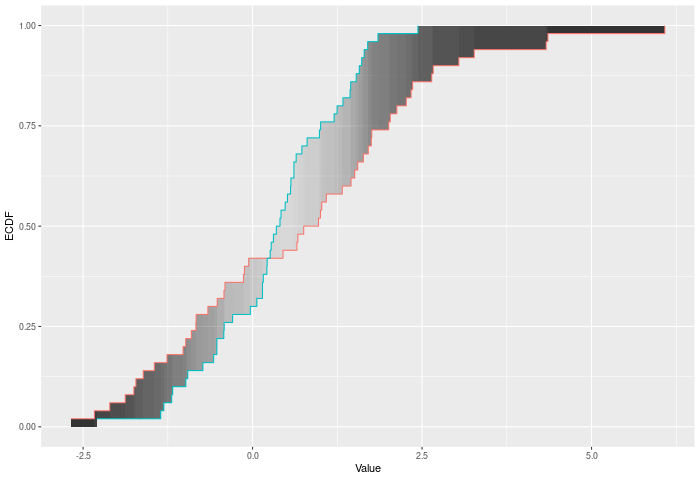
Inputs a and b can also be vectors of ordered (or unordered) factors, so long as both have the same levels and orderings. When possible, ordering factors will substantially increase power. The dts test will assume the distance between adjacent factors is 1.
Value
Output is a length 2 Vector with test stat and p-value in that order. That vector has 3 attributes – the sample sizes of each sample, and the number of bootstraps performed for the pvalue.
Functions
-
dts_test(): Permutation based two sample test -
two_sample(): Recommended two-sample test -
dts_stat(): Permutation based two sample test
See Also
wass_test(), ad_test() for the predecessors of this test statistic. arXiv:2007.01360 or https://codowd.com/public/DTS.pdf for details of this test statistic
Examples
set.seed(314159)
vec1 = rnorm(20)
vec2 = rnorm(20,0.5)
dts_stat(vec1,vec2)
out = dts_test(vec1,vec2)
out
summary(out)
plot(out)
two_sample(vec1,vec2)
# Example using ordered factors
vec1 = factor(LETTERS[1:5],levels = LETTERS,ordered = TRUE)
vec2 = factor(LETTERS[c(1,2,2,2,4)],levels = LETTERS, ordered=TRUE)
dts_test(vec1,vec2)
Wasserstein Distance Test
Description
A two-sample test based on Wasserstein's distance (wass_stat).
Usage
wass_test(a, b, nboots = 2000, p = default.p, keep.boots = T, keep.samples = F)
wass_stat(a, b, power = def_power)
Arguments
a |
a vector of numbers (or factors – see details) |
b |
a vector of numbers |
nboots |
Number of bootstrap iterations |
p |
power to raise test stat to |
keep.boots |
Should the bootstrap values be saved in the output? |
keep.samples |
Should the samples be saved in the output? |
power |
power to raise test stat to |
Details
The Wasserstein test compares two ECDFs by looking at the Wasserstein distance between the two. This is of course the area between the two ECDFs. Formally – if E is the ECDF of sample 1 and F is the ECDF of sample 2, then
WASS = \int_{x \in R} |E(x)-F(x)|^p
across all x. The test p-value is calculated by randomly resampling two samples of the same size using the combined sample. Intuitively the Wasserstein test improves on CVM by allowing more extreme observations to carry more weight. At a higher level – CVM/AD/KS/etc only require ordinal data. Wasserstein gains its power because it takes advantages of the properties of interval data – i.e. the distances have some meaning.
In the example plot below, the Wasserstein statistic is the shaded area between the ECDFs.
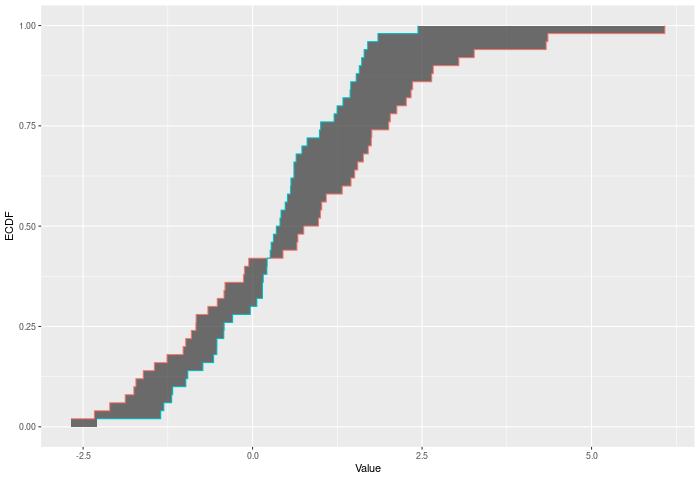
Inputs a and b can also be vectors of ordered (or unordered) factors, so long as both have the same levels and orderings. When possible, ordering factors will substantially increase power. wass_test will assume the distance between adjacent factors is 1.
Value
Output is a length 2 Vector with test stat and p-value in that order. That vector has 3 attributes – the sample sizes of each sample, and the number of bootstraps performed for the pvalue.
Functions
-
wass_test(): Permutation based two sample test using Wasserstein metric -
wass_stat(): Permutation based two sample test using Wasserstein metric
See Also
dts_test() for a more powerful test statistic. See cvm_test() for the predecessor to this test statistic. See dts_test() for the natural successor of this test statistic.
Examples
set.seed(314159)
vec1 = rnorm(20)
vec2 = rnorm(20,0.5)
out = wass_test(vec1,vec2)
out
summary(out)
plot(out)
# Example using ordered factors
vec1 = factor(LETTERS[1:5],levels = LETTERS,ordered = TRUE)
vec2 = factor(LETTERS[c(1,2,2,2,4)],levels = LETTERS, ordered=TRUE)
wass_test(vec1,vec2)